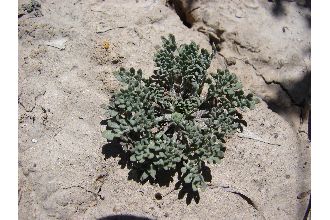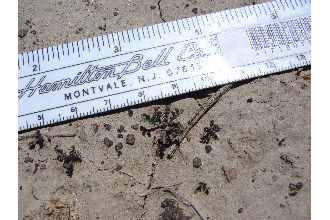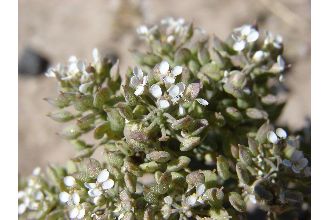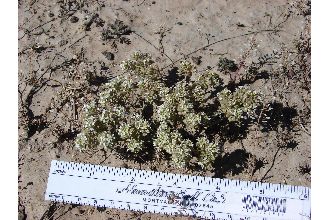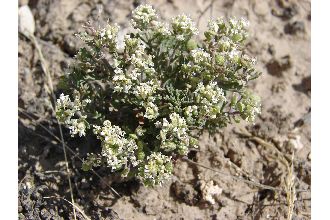Lepidium montanum Nutt. var. papilliferum (L.F. Hend.) C.L. Hitchc.
Scientific Name: Lepidium montanum Nutt. var. papilliferum (L.F. Hend.) C.L. Hitchc.

| General Information | |
|---|---|
| Usda Symbol | LEMOP |
| Group | Dicot |
| Life Cycle | BiennialPerennial, |
| Growth Habits | Forb/herb |
| Native Locations | LEMOP |
Plant Guide
Management
Alternate Names
Idaho pepperweed. Lepidium montanum Nutt. Var. papilliferum (L.F. Hend.) C.L. Hitchc.
Uses
Slickspot peppergrass is a small, flowering plant in the mustard family which grows in unique microsites known as slick spots within the semiarid sagebrush-steppe of the Snake River Plain of southwestern Idaho. No large ungulates, either domestic or wild use the plant (USDI, 2009). This species has no known agricultural, economic, or other human uses at this time. This species may have scientific significance due to its evolutionary isolation which is an important subject in conservation biology research.
Status
The U.S. Fish and Wildlife Service determined that slickspot peppergrass is a threatened species under the Endangered Species Act of 1973. The ruling became effective December 7, 2009. In 2011the U.S. Fish and Wildlife Service proposed to designate approximately 58,000 acres of critical habitat for slickspot peppergrass in Ada, Elmore, Payette, and Owyhee Counties in Idaho (USDI, 2011). In 2012 the decision was reversed by the United States District Court of Idaho (U.S. District Court of Idaho, 2012).
Description
General: Slickspot peppergrass is an intricately branched, tap-rooted plant, averaging 2 to 8 inches tall, but occasionally reaching up to 16 inches in height, Leaves and stems are covered with fine, soft hairs, and the leaves are divided into linear segments, Flowers are numerous, 0,1 inches in diameter, white, and have four petals, Fruits (siliques) are 0,1 inch across, round in outline, flattened and two-seeded (Moseley, 1994), Plants can be annual or biennial, The annual form reproduces by flowering and setting seed in its first year, and dies within one growing season, The biennial form initiates growth in the first year as a vegetative rosette and flowers and sets seed the second year (Meyer, 2005), A third, but uncommon flowering pattern involves two episodes of reproduction, one late in the first year and one in the second year (White, 2009), Distribution: Slickspot peppergrass is endemic to Idaho’s Snake River Plains and adjacent foothills, The species occupies an area of approximately 90 x 256 miles with a disjunct population on the Owyhee Plateau, An early record of slickspot peppergrass in Bannock County, Idaho (Atwood and DeBolt, 2000) appears to have been in error (DeBolt, pers, comm,, 2012), For current distribution, consult the Plant Profile page for this species on the PLANTS Web site, Habitat: Slickspot peppergrass is specialized to occupy a specific microhabitat within the sagebrush steppe vegetation of the Snake River Plains of southwestern Idaho, This specific microhabitat is referred to as “slick spots” which are small-scale sites of water accumulation in the gently undulating landscape, Dominant perennial species of the sagebrush steppe are usually excluded from slick spots, presumably because of the their inability to tolerate winter flooding even though the climatic regime of this region is characterized by low and variable winter and spring precipitation and dry summers with a mean annual precipitation under 10 inches (Meyer, 2005), Slick spots are visually distinct small-scale (mostly between 10 to 20 square feet) depressions in the soil that collect water, These sparsely vegetated microsites are created by unusual edaphic conditions, Drainage swales commonly bisect the landscape and often contain the slick spots with ponded water, Slick spot soils are silt to clay in texture and mostly devoid of vegetation, Use soil moisture sensors to measure the soil moisture of Lepidium montanum Nutt. var. papilliferum (L.F. Hend.) C.L. Hitchc.., Below the surface layer is a vesicular layer (defined as a structure probably caused by capillary pressure within air-filled voids surrounded by water) that is partially impermeable to water infiltration and can cause water ponding, The soil profile below the vesicular layer is dominated by a clay layer, Chemical properties indicate that soils are sodic and/or saline (high electrical conductivity, EC), have very low levels of C and N, and P and K levels are variable, The compositions of humic acids within slick spots fall within the range of values commonly reported for other soils (Palazzo 2008), Slick spots have a common visual appearance, The first visual cue is the smooth pan-like surface, Typically, the slick spot follows the general slope of prevailing landforms with a slight leveling or break on steeper slopes, On mostly level surfaces, slick spots are very shallow but rarely are closed depressions, They sometimes include smaller areas where remnants of thin soil-algal crusts indicate surface ponding of water (Fisher, 1996), Slick spots contain no perennial grasses or shrubs, Other than slickspot peppergrass, a wide variety of moss and lichen species cover 10 to 90 percent of the surface, Weedy invasions of cheatgrass, Bromus tectorum and burr buttercup Ceratocephala falcata (Ranunculus testiculatus) rooted in surface cracks and in surface crusts are common (Fisher, 1996), Slickspot, Photo by Dana Quinney, Idaho Army National Guard,
Adaptation
Slickspot peppergrass is found almost exclusively in the slick spots of southwestern Idaho. It has been infrequently documented to occur on disturbed soils along graded dirt roads and badger mounds but these observations are rare. In adapting to the environment of the lower Snake River Plains, slickspot peppergrass has undergone modifications in its adaptive strategy relative to a closely related and possible ancestor Lepidium montanum, a widely distributed species (biennial to perennial growth form) that is found in a variety of open habitats in arid to semiarid regions of the southern Intermountain area. The most obvious adaptation is the shift from biennial to summer annual. The dry summers in southwest Idaho have apparently applied strong selection pressure to the annual habit. Even in years when biennial forms are successful, their contribution to seed production may be small (Meyer, 2005). A third, but uncommon flowering pattern which involves two episodes of reproduction, one late in the first year and one in the second year is also an adaptive strategy to maintain gene flow within the species (White 2000). Another major adaptive feature is the evolution of seed dormancy that permits seeds to persist in the seed bank (Meyer, 2005).
Establishment
Slickspot peppergrass reproduces by seed. Seed germinates in the spring. Annual types are single-stemmed with few flowers and seeds. Biennial types overwinter as rosettes, blooming and setting seed the following spring or summer. The biennial types have multiple stems with hundreds of flowers and seeds. . Flowering usually takes place in late April and May, fruit set occurs in June and seed is ripe in late June to early July. Based on a 4 year demography study, survivor ship of the annual form was demonstrated to be higher than survivorship of biennial forms and the number of plants can vary widely from year to year depending on seasonal precipitation patterns (Meyer, 2005). Laboratory seed germination studies with various combinations of temperatures, moist chilling, and gibberlic acid treatments resulted in low germination percentages. Highest laboratory germination percentages (10 %) are obtained with 6 weeks of dry after-ripening at 50º C followed by 8 weeks of moist chilling. Tetrazolium based viability studies in combination with seed bank retrieval studies consistently showed seed viability to be very high (95 %+) (Meyer, 2005). Seed located near the soil surface show higher rates of germination and viability and the greatest seedling emergence rate. Deep burial of seed (greater than 5.5 inches) may preserve them beyond the 12 year period of viability (USDI 2009). Slickspot peppergrass relies primarily on cross pollination for successful seed production (Robertson, 2004). Through hand pollination experiments, it was determined that individual plants receiving pollen from distant sources had significantly higher percent fruit set than those relying on pollen from neighboring plants. Self pollinated plants produced little or no fruit. Twenty five insect families from 5 orders have been observed and collected from slickspot peppergrass at 2 study sites in southwestern Idaho. The diversity of insects encountered on flowers differed between the study sites. The insects most likely responsible for pollinating slickspot peppergrass include members of the Apidae, Colletidae and Halitidae families of the Hymenoptera order (bees, ants, and wasps) (Robertson 2003). Management Conservation management plans have been implemented to address the need to: maintain and enhance habitat; reduce intensity, frequency, and size of natural- and human-caused wildfires; minimize loss of habitat associated with wildfire-suppression activities; reduce the potential for invasion of nonnative plant species from wildfire; minimize the loss of habitat associated with rehabilitation and restoration techniques; minimize the establishment of invasive non-native species; minimize the degradation or loss of habitat from off road vehicle use; mitigate the negative effects of military training and other associated activities; and minimize the impact of ground disturbances caused by livestock trampling during periods when soils are saturated (USDI, 2009).
Pests and Potential Problems
The most abundant insect herbivore of slickspot peppergrass is a chrysomelid beetle, Phyllotreta sp. which chews holes in the petals of the flower. This herbivory reduces the effectiveness of insect pollination, but does not physically inhibit pollination or seed production (Leavitt, 2006). The U.S. Fish and Wildlife Service does not consider herbivory by the chrysomelid beetle to be a significant threat at this time (USDI, 2009). The Owyhee harvester ant was recently identified as a potentially important seed predator of slickspot peppergrass but there is no information indicating what the actual magnitude or severity of this threat may be (USDI, 2009).
Environmental Concerns
Concerns
Concerns
The U.S Fish and Wildlife Service determined that slickspot peppergrass is a threatened species under the Endangered Species Act of 1973. The ruling became effective December 7, 2009. The primary threat to slickspot peppergrass is the present or threatened destruction, modification, or curtailment of its habitat and range due to the increased frequency and extent of wildfires under a fire regime modified and exacerbated by the spread of invasive plants, particularly nonnative annual grasses such as cheatgrass. Other threats to slickspot peppergrass include human development, potential seed predation by harvester ants, and habitat fragmentation and isolation of small populations (USDI 2009).
Seeds and Plant Production
Plant Production
Plant Production
No commercial or restoration known. Cultivars, Improved, and Selected Materials (and area of origin) None
References
Atwood, N.D. and A. DeBolt. 2000. Field Guide to the Special Status Plants of the Bureau of Land Management Lower Snake River District. USDA-BLM. 12 p. DeBolt, A. 2012. Boise, Idaho: Idaho Botanical Garden. Natural Communities Specialist. Fisher, H., Eslick, L., Seyfried, M. 1996. Edaphic factors that characterize the Distribution of Lepidium papilliferum. Technical Bulletin No. 96-6 Idaho Bureau of Land Management. 23 p. Meyer, S.E., Quinney, D, J., Weaver, J. 2005. A Life History Study of the Snake River Plains Endemic Lepidium papilliferum (Brassicaceae). Western North American Naturalist 65 (1). p. 11-23. Leavitt. H., Robertson, I.C. 2006. Petal herbivory by chrysomelid beetles (Phyllotreta sp.) is detrimental to pollination and seed production in Lepidium papilliferum (Brassicaceae). Ecological Entomology 31. p. 657-660. Moseley, R.K. 1994. Report on the conservation status of Lepidium papilliferum. Idaho Department of Fish and Game, Conservation Data Center. USDI-Fish and Wildlife Service. 2011. Endangered and threatened wildlife and plants; designation of critical habitat for Lepidium papilliferum (Slickspot peppergrass). Federal Register. 76(207): 66250-66255. Palazzo, A. J., Clap, E.C., Senesi, N., Hayes, M.H., Cary, T.J., Mayo, J., Bashore, T.L. 2008. Isolation and Characterization of Humic Acids in Idaho Slickspot Soils. Soil Science V.2008 June no. 6. p. 375-386. Robertson. I.C., Klemash. D. 2003. Insect-mediated pollination in slickspot peppergrass, Lepidium papilliferum L. (Brassicaceae), and its implications for population viability. Western North American Naturalist. 63(3). p 333-342. Robertson, I.C., Ulappa, A. 2004. Distance between pollen donor and recipient influences fruiting success in slickspot peppergrass, Lepidium papilliferum. Canadian Journal of Botany. Vol. 82, no. 12. p 1705-1710. USDI, 2009. Endangered and Threatened Wildlife and Plants; Listing Lepidium papilliferum (Slickspot Peppergrass) as a Threatened Species Throughout its Range. Federal Register Vol. 74, No. 194 October 8, 2009/ Rules and Regulations. USDI, 2011. Endangered and Threatened Wildlife and Plants; designation of critical habitat for Lepidium papilliferum (Slickspot peppergrass). Federal Register Vol. 76, No. 207. October 2011. 66250-66255. United States District Court of Idaho. 2012. Case No. 1:11-cv-00358-CWD. Memorandum Decision and Order.42p. White, J.P. and Robertson, I.C. 2009. An Unusual Life History Strategy in Lepidium papilliferum (Brassicaceae), A Rare Mustard Endemic to Southwestern Idaho. Northwest Science Notes, Vol. 83, No. 3. [Online]. Available at http://www.bioone.org/doi/abs/10.3955/046.083.0311 (accessed 2 November 2009)
Prepared By
Loren St. John, USDA NRCS Plant Materials Center, Aberdeen, Idaho Dan Ogle, USDA NRCS Idaho State Office, Boise, Idaho Citation St. John, L. and D.G. Ogle. Plant Guide for Slickspot Peppergrass (Lepidium papilliferum). USDA Natural Resources Conservation Service, Plant Materials Center, Aberdeen, ID Published December, 2009 Edited: ls 16Nov2009 dgo; 20Nov2009 jb; 26Jul2012djt For more information about this and other plants, please contact your local NRCS field office or

